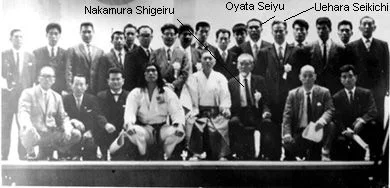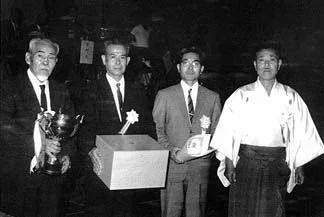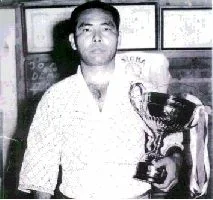From the rec.martialarts FAQ
(Contributors: Howard S. High - GODZILLA@kuhub.cc.ukans.edu,
Avron Boretz - aab2@cornell.edu,
Izar Tarandach - izar@cs.huji.ac.il,
Richard Parry - parry_r@kosmos.wcc.govt.nz)
Intro:
Somewhat generic term used for Japanese and Okinawan fighting arts.
Origin: Okinawa
History:
Karate is a term that either means "Chinese hand" or "Empty hand"
depending on which Japanese or Chinese characters you use to write it.
The Okinawan Karates could be said to have started in the 1600s when
Chinese practitioners of various Gongfu styles mixed and trained with
local adherents of an art called "te" (meaning "hand") which was a
very rough, very simple fighting style similar to Western boxing.
These arts generally developed into close- range, hard, external
styles.
In the late 19th century Gichin Funakoshi trained under several of the
great Okinawan Karate masters (Itosu, Azato) as well as working with
Jigoro Kano (see Judo) and Japanese Kendo masters (see Kendo).
Influenced by these elements, he created a new style of Karate. This
he introduced into Japan in the first decade of the 20th century and
thus to the world. The Japanese Karates (or what most people refer to
when they say "karate") are of this branch.
Description:
Okinawan Karate styles tend to be hard and external. In defense they
tend to be circular, and in offense linear. Okinawan karate styles
tend to place more emphasis on rigorous physical conditioning than the
Japanese styles. Japanese styles tend to have longer, more stylistic
movements and to be higher commitment. They also tend to be linear in
movement, offense, and defense.
Both tend to be high commitment, and tend to emphasize kicks and
punches, and a strong offense as a good defense.
Training:
This differs widely but most of the Karate styles emphasize a fairly
equal measure of basic technique training (repitition of a particular
technique), sparring, and forms. Forms, or kata, as they are called,
are stylized patterns of attacks and defenses done in sequence for
training purposes.
Sub-Styles: (Okinawan): Uechi-Ryu, Goju-Ryu, Shorin-Ryu, Isshin-Ryu
(Japanese): Shotokan, Shito-Ryu, Wado-Ryu
Here is a more complete list (complements of Howard High) in which
Okinawan and Japanese styles are mixed:
Ashihara, Chinto-Ryu, Chito-Ryu, Doshinkan, Gohaku-Kai, Goju-Ryu
(Kanzen), Goju-Ryu (Okinawan), Goju-Ryu (Meibukan), Gosoku-Ryu,
Isshin-Ryu, Kenseido, Koei-Kan, Kosho-Ryu Kenpo, Kyokushinkai, Kyu
Shin Ryu, Motobu-Ryu, Okinawan Kempo, Okinawa Te, Ryokukai, Ryuken,
Ryukyu Kempo, Sanzyu-Ryu , Seido, Seidokan, Seishin-Ryu, Shindo
Jinen-Ryu, Shinjimasu, Shinko-Ryu, Shito-Ryu (Itosu-Kai), Shito-Ryu
(Seishinkai), Shito-Ryu (Kofukan), Shito-Ryu (Kuniba Ha) , Shito-Ryu
(Motobu Ha), Shorin-Ryu (Kobayashi), Shorin-Ryu (Matsubayashi),
Shorin-Ryu (Shobayashi), Shorin-Ryu (Matsumura), Shorinji Kempo,
Shorinji-Ryu, Shoshin-Ryu, Shotokai, Shotokan, Shotoshinkai, Shudokai,
Shuri-Ryu, Shuri-Te, Uechi-Ryu , Wado-Kai, Wado-Ryu, Washin-Ryu,
Yoseikan, Yoshukai, Yuishinkan.
Sub-Style Descriptions:
Wado-Ryu was founded by Hironori Ohtsuka around the 1920s. Ohtsuka
studied Jujutsu for many years before becoming a student of Gichin
Funakoshi. Considered by some to be Funakoshi's most brilliant
student, Ohtsuka combined the movements of Jujutsu with the striking
techniques of Okinawan Karate. After the death of Ohtsuka in the early
1980s, the style split into two factions: Wado Kai, headed by
Ohtsuka's senior students; and Wado Ryu, headed by Ohtsuka's son,
Jiro. Both factions continue to preserve most of the basic elements of
the style.
Uechi-ryu Karate, although it has become one of the main Okinawan
martial arts and absorbed many of the traditional Okinawan karate
training methods and approaches, is historically, and to some extent
technically quite separate. The "Uechi" of Uechi-ryu commemorates
Uechi Kanbun, an Okinawan who went to Fuzhou, the capital city of
Fujian province in China in 1897 to avoid being drafted into the
Japanese army. There he studied under master Zhou Zihe for ten years,
finally opening his own school, one of the few non-Chinese who
ventured to do so at the time. The man responisble for bringing
Uechi-ryu to the US is George Mattson.
Uechi-ryu, unlike the other forms of Okinawan and Japanese karate
mentioned in the FAQ, is only a few decades removed from its Chinese
origins. Although it has absorbed quite a bit of Okinawan influence
and evolved closer to such styles as Okinawan Goju-ryu over those
decades, it still retains its original Chinese flavor, both in its
technique and in the culture of the dojo. It is a "half-hard,
half-soft" style very similar to such southern Chinese styles as
Fukienese Crane (as still practiced in the Chinese communities of
Malaysia), Taiwanese Golden Eagle, and even Wing Chun. Conditioning
the body for both attack and defense is a common characteristic of
both Okinawan karate and southern Shaolin "street" styles, and as such
is an important part of Uechi training. There is a strong internal
component to the practice, including focused breathing and tensioning
exercises similar to Chinese Qigong. Uechi, following its Chinese
Crane heritage, emphasizes circular blocks, low snap kicks, infighting
(coordinating footwork with grabs, locks, throws, and sweeps), and
short, rapid hand traps and attacks (not unlike Wing Chun).
(Contributors: Howard S. High - GODZILLA@kuhub.cc.ukans.edu,
Avron Boretz - aab2@cornell.edu,
Izar Tarandach - izar@cs.huji.ac.il,
Richard Parry - parry_r@kosmos.wcc.govt.nz)
Intro:
Somewhat generic term used for Japanese and Okinawan fighting arts.
Origin: Okinawa
History:
Karate is a term that either means "Chinese hand" or "Empty hand"
depending on which Japanese or Chinese characters you use to write it.
The Okinawan Karates could be said to have started in the 1600s when
Chinese practitioners of various Gongfu styles mixed and trained with
local adherents of an art called "te" (meaning "hand") which was a
very rough, very simple fighting style similar to Western boxing.
These arts generally developed into close- range, hard, external
styles.
In the late 19th century Gichin Funakoshi trained under several of the
great Okinawan Karate masters (Itosu, Azato) as well as working with
Jigoro Kano (see Judo) and Japanese Kendo masters (see Kendo).
Influenced by these elements, he created a new style of Karate. This
he introduced into Japan in the first decade of the 20th century and
thus to the world. The Japanese Karates (or what most people refer to
when they say "karate") are of this branch.
Description:
Okinawan Karate styles tend to be hard and external. In defense they
tend to be circular, and in offense linear. Okinawan karate styles
tend to place more emphasis on rigorous physical conditioning than the
Japanese styles. Japanese styles tend to have longer, more stylistic
movements and to be higher commitment. They also tend to be linear in
movement, offense, and defense.
Both tend to be high commitment, and tend to emphasize kicks and
punches, and a strong offense as a good defense.
Training:
This differs widely but most of the Karate styles emphasize a fairly
equal measure of basic technique training (repitition of a particular
technique), sparring, and forms. Forms, or kata, as they are called,
are stylized patterns of attacks and defenses done in sequence for
training purposes.
Sub-Styles: (Okinawan): Uechi-Ryu, Goju-Ryu, Shorin-Ryu, Isshin-Ryu
(Japanese): Shotokan, Shito-Ryu, Wado-Ryu
Here is a more complete list (complements of Howard High) in which
Okinawan and Japanese styles are mixed:
Ashihara, Chinto-Ryu, Chito-Ryu, Doshinkan, Gohaku-Kai, Goju-Ryu
(Kanzen), Goju-Ryu (Okinawan), Goju-Ryu (Meibukan), Gosoku-Ryu,
Isshin-Ryu, Kenseido, Koei-Kan, Kosho-Ryu Kenpo, Kyokushinkai, Kyu
Shin Ryu, Motobu-Ryu, Okinawan Kempo, Okinawa Te, Ryokukai, Ryuken,
Ryukyu Kempo, Sanzyu-Ryu , Seido, Seidokan, Seishin-Ryu, Shindo
Jinen-Ryu, Shinjimasu, Shinko-Ryu, Shito-Ryu (Itosu-Kai), Shito-Ryu
(Seishinkai), Shito-Ryu (Kofukan), Shito-Ryu (Kuniba Ha) , Shito-Ryu
(Motobu Ha), Shorin-Ryu (Kobayashi), Shorin-Ryu (Matsubayashi),
Shorin-Ryu (Shobayashi), Shorin-Ryu (Matsumura), Shorinji Kempo,
Shorinji-Ryu, Shoshin-Ryu, Shotokai, Shotokan, Shotoshinkai, Shudokai,
Shuri-Ryu, Shuri-Te, Uechi-Ryu , Wado-Kai, Wado-Ryu, Washin-Ryu,
Yoseikan, Yoshukai, Yuishinkan.
Sub-Style Descriptions:
Wado-Ryu was founded by Hironori Ohtsuka around the 1920s. Ohtsuka
studied Jujutsu for many years before becoming a student of Gichin
Funakoshi. Considered by some to be Funakoshi's most brilliant
student, Ohtsuka combined the movements of Jujutsu with the striking
techniques of Okinawan Karate. After the death of Ohtsuka in the early
1980s, the style split into two factions: Wado Kai, headed by
Ohtsuka's senior students; and Wado Ryu, headed by Ohtsuka's son,
Jiro. Both factions continue to preserve most of the basic elements of
the style.
Uechi-ryu Karate, although it has become one of the main Okinawan
martial arts and absorbed many of the traditional Okinawan karate
training methods and approaches, is historically, and to some extent
technically quite separate. The "Uechi" of Uechi-ryu commemorates
Uechi Kanbun, an Okinawan who went to Fuzhou, the capital city of
Fujian province in China in 1897 to avoid being drafted into the
Japanese army. There he studied under master Zhou Zihe for ten years,
finally opening his own school, one of the few non-Chinese who
ventured to do so at the time. The man responisble for bringing
Uechi-ryu to the US is George Mattson.
Uechi-ryu, unlike the other forms of Okinawan and Japanese karate
mentioned in the FAQ, is only a few decades removed from its Chinese
origins. Although it has absorbed quite a bit of Okinawan influence
and evolved closer to such styles as Okinawan Goju-ryu over those
decades, it still retains its original Chinese flavor, both in its
technique and in the culture of the dojo. It is a "half-hard,
half-soft" style very similar to such southern Chinese styles as
Fukienese Crane (as still practiced in the Chinese communities of
Malaysia), Taiwanese Golden Eagle, and even Wing Chun. Conditioning
the body for both attack and defense is a common characteristic of
both Okinawan karate and southern Shaolin "street" styles, and as such
is an important part of Uechi training. There is a strong internal
component to the practice, including focused breathing and tensioning
exercises similar to Chinese Qigong. Uechi, following its Chinese
Crane heritage, emphasizes circular blocks, low snap kicks, infighting
(coordinating footwork with grabs, locks, throws, and sweeps), and
short, rapid hand traps and attacks (not unlike Wing Chun).



